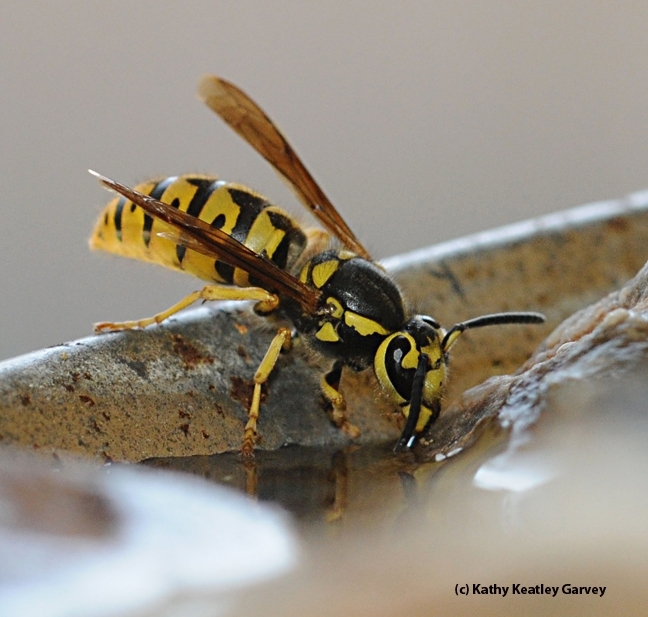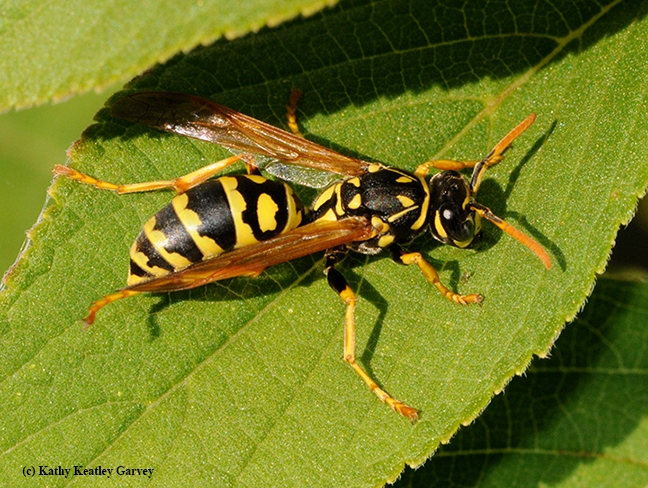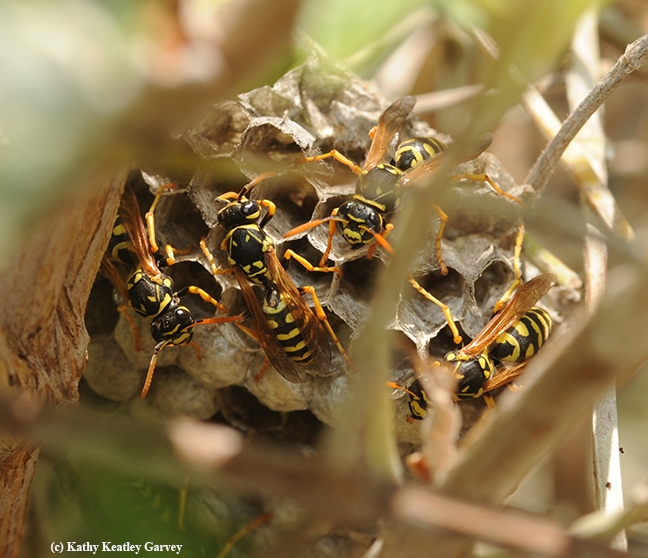- Author: Kathy Keatley Garvey
Bees, butterflies, beetles, birds and bats.
What do they have in common? Skipping the alliteration for a moment, they're all pollinators.
Honey bees grab the most attention, of course, and they do the bulk of the work. But so do bumble bees and other native bees.
But other pollinators include moths, hummingbirds, wasps and flies (especially the syrphid flies, aka hover flies or flower flies often mistaken for honey bees by the untrained eye.)
The National Park Service describes pollination as "anything that helps carry pollen from the male part of the flower (stamen) to the female part of the same or another flower (stigma). The movement of pollen must occur for the plant to become fertilized and produce fruits, seeds, and young plants. Some plants are self-pollinating, while others may be fertilized by pollen carried by wind or water. Still, other flowers are pollinated by insects and animals - such as bees, wasps, moths, butterflies, birds, flies and small mammals, including bats."
"At least 75 percent of all the flowering plants on earth are pollinated by insects and animals," they point out on their website. "This amounts to more than 1,200 food crops and 180,000 different types of plants—plants which help stabilize our soils, clean our air, supply oxygen, and support wildlife."
One pollinator that absolutely takes our breath away is the Western tiger swallowtail, Papilio rutulus, especially when it touches down on the colorful Mexican sunflower, Tithonia rotundifola, and begins to nectar.
If you're lucky, you'll see different species sharing the same blossom.
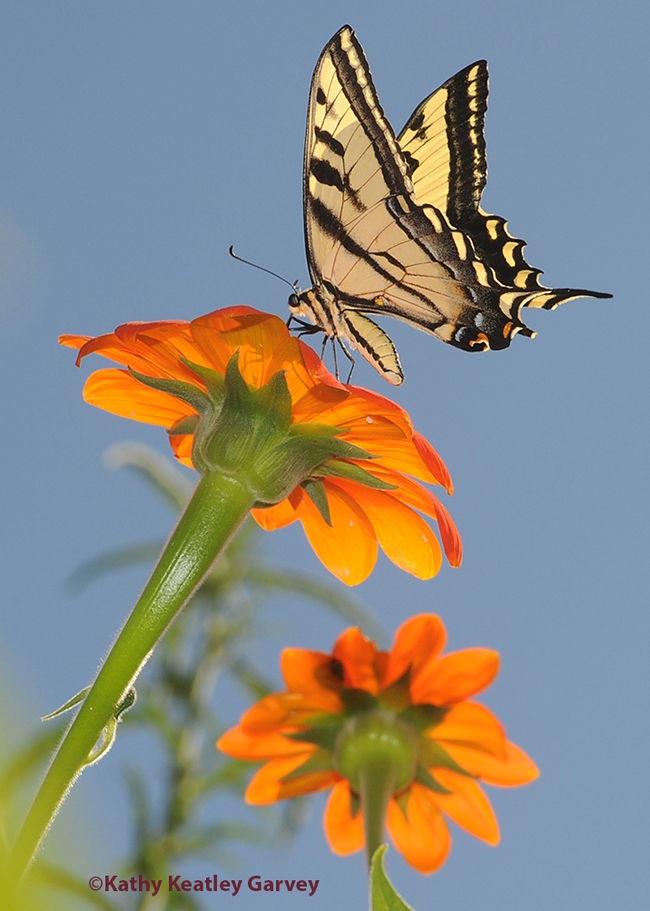
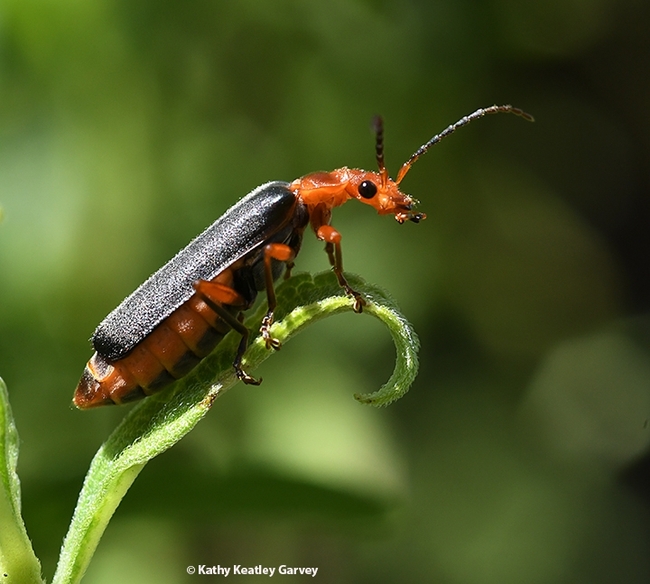
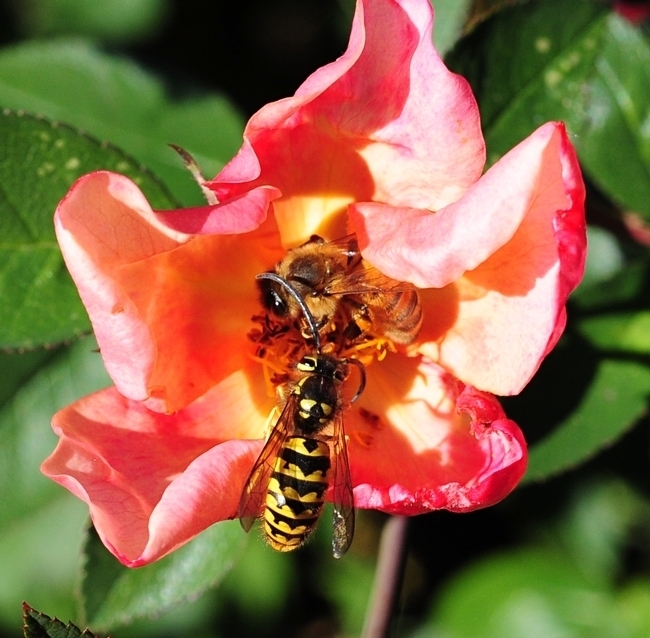
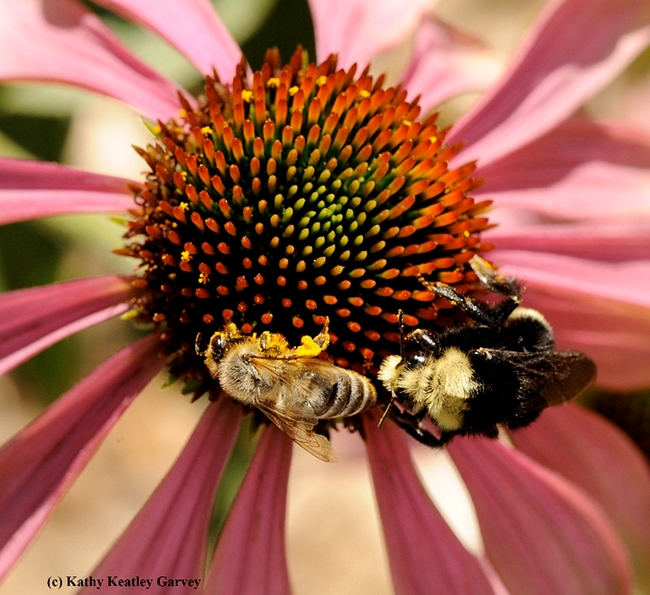
- Author: Kathy Keatley Garvey
Who takes images of yellowjackets?
What, nobody?
I don't usually photograph yellowjackets because (1) I prefer to take images of their cousins, the honey bees and (2) yellowjackets are always moving. By the time I observe one, and raise the camera, the insect is long gone.
You've probably seen yellowjackets hosting their "huge family reunions" at your picnic table. These uninvited guests help themselves to your food, especially such protein as hamburgers and hot dogs--and sugary substances like cake and soft drinks. Avoid the 'jackets. They can be very aggressive.
However, a trip on Aug. 31 to Doran Regional Park Beach, Bodega Bay, proved to be "Yellowjacket Portrait Day" or "Getting Social with a Social Wasp." It all began around dawn when I noticed movement in a blooming Myoporum (a genus of flowering plants in the figwort family, Scrophulariaceae).
Then I spotted a western yellowjacket, Vespula pensylvanica, staring at me. Take my picture! C'mon! I'm a social wasp. Don't you think I deserve a picture, what with all you humans forever targeting me?
Okay, stay still. Don't return to your nest right now. And if you do, don't bring back your nestmates."
"Yellowjackets are social wasps that build large, hidden nests," writes Lynn Kimsey, director of the Bohart Museum of Entomology and a UC Davis distinguished professor of entomology, on an online fact sheet. "The nests are usually subterranean in rodent burrows or in cavities in trees, walls or attics. "
"Yellowjacket nests can be huge with 50,000 to 100,000 workers," Kimsey points out. "In temperate climates these colonies are annual. Their nests die in the fall after producing new queens. New queens produced by the colonies in the fall spend the winter in protected places until spring when they found new colonies. Yellow jacket colonies can become perennial in warmer climates, such as in Hawaii and coastal California. In these situations the nests can become enormous, with millions of workers!"
Says the UC Statewide Integrated Pest Management (UC IPM) Program in its Pest Note on "Yellowjackets and Other Social Wasps": "In California, yellowjackets are the primary pests among the social wasps. In Western states there are two distinct types of social wasps—yellowjackets and paper wasps. Yellowjackets are by far the most troublesome group, especially ground- and cavity-nesting ones such as the western yellowjacket, which tend to defend their nests vigorously when disturbed. Defensive behavior increases as the season progresses and colony populations become larger while food becomes scarcer. In fall, foraging yellowjackets are primarily scavengers, and they start to show up at picnics and barbecues, around garbage cans, at dishes of dog or cat food placed outside, and where ripe or overripe fruit are accessible. At certain times and places, the number of scavenger wasps can be quite large."
UC IPM goes on to note that "Concern about yellowjackets is based on their persistent, pugnacious behavior around food sources and their aggressive defense of their colony. Usually stinging behavior is encountered at nesting sites, but sometimes scavenging yellowjackets will sting if someone tries to swat them away from a potential food source. When scavenging at picnics or other outdoor meals, wasps will crawl into soda cans and can sting your lips or the inside of your mouth or throat."
However, "Most social wasps provide an extremely beneficial service by eliminating large numbers of other pest insects through predation and should be protected and encouraged to nest in areas of little human or animal activity," UC IPM relates. "Although many animals prey on social wasps—including birds, reptiles, amphibians, skunks, bears, raccoons, spiders, praying mantids, and bald-faced hornets—none provides satisfactory biological control in home situations." (Read more on the UC IPM site)
So what happened to the solo yellowjacket at Bodega Bay? It hung around for several minutes and then took flight.
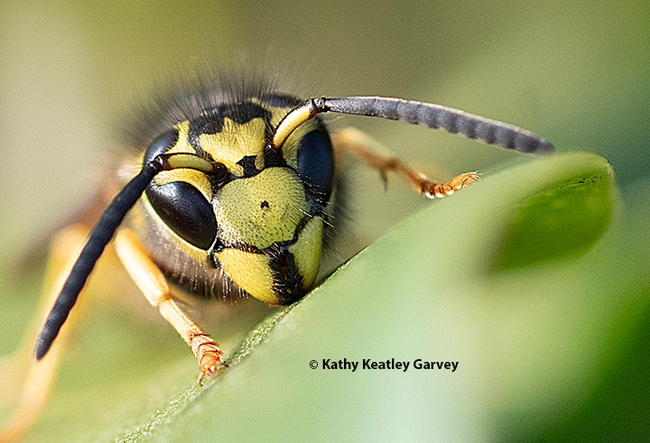
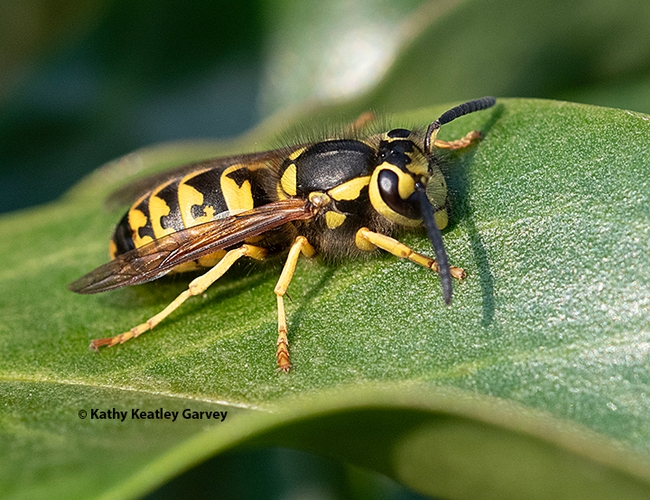
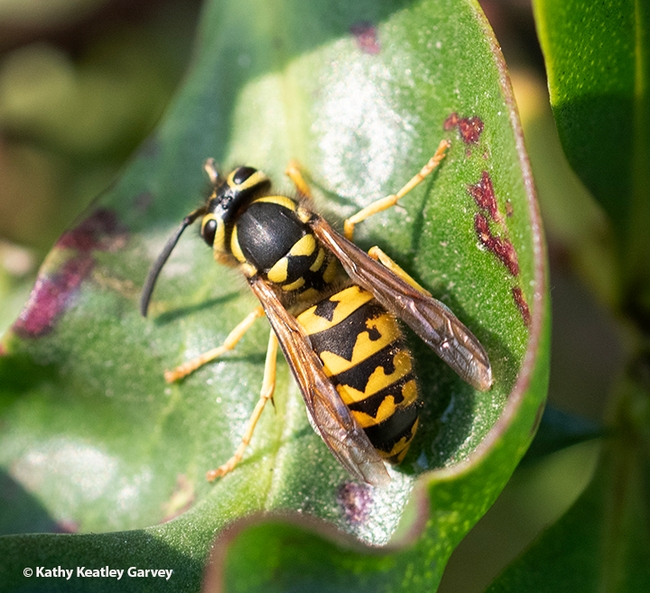
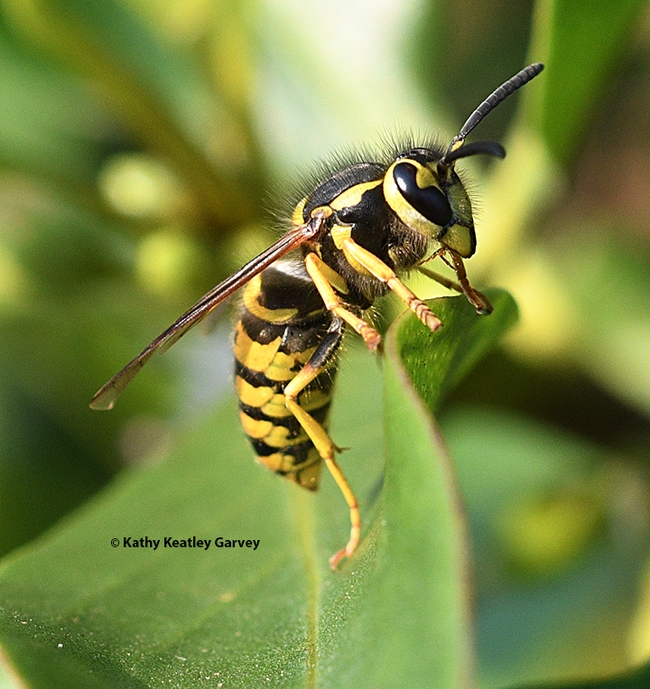
- Author: Kathy Keatley Garvey
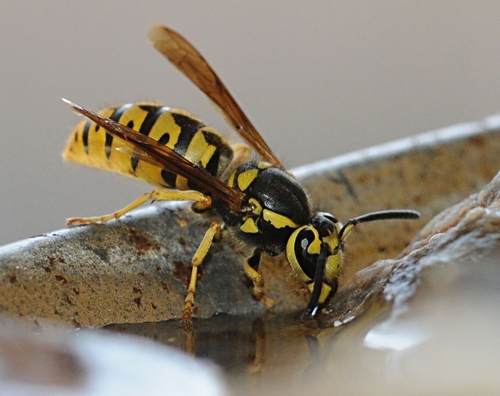
Yellowjackets, commonly known as "meat bees," in comparison to the "vegetarian" honey bees, will be among the wasps featured at the Bohart Museum of Entomology's open house from 1 to 4 p.m., Sunday, Sept. 25 in Room 1124 of the Academic Surge Building, 455 Crocker Lane, UC Davis campus. The theme: "Weird and Wonderful Wasps."
The open house is free and family friendly. A family arts and crafts activity is also planned.
"Yellowjackets are social wasps that build large, hidden nests," writes Lynn Kimsey, director of the Bohart Museum and a UC Davis distinguished professor of entomology, on one of her online fact sheets. "The nests are usually subterranean in rodent burrows or in cavities in trees, walls or attics.
"Yellow jacket nests can be huge with 50,000 to 100,000 workers," Kimsey points out. "In temperate climates these colonies are annual. Their nests die in the fall after producing new queens. New queens produced by the colonies in the fall spend the winter in protected places until spring when they found new colonies. Yellow jacket colonies can become perennial in warmer climates, such as in Hawaii and coastal California. In these situations the nests can become enormous, with millions of workers!"
Kimsey says that yellowjacket nests "can be distinguished from paper wasp nests because the brood cells are encased in a paper envelope so they can't be seen without taking off the outer envelope. These wasps generally feed on live prey, but the pest species, such as Vespula pensylvanica, will scavenge other sources of meat and sugar, including sodas, hamburgers and road kill. They will also visit aphids and scale insects for honeydew."
At the open house, visitors will learn about the smallest fairy wasps to the "murder hornets"; what role wasps play in plant galls and figs; and how to distinguish a parasitoid from a parasite. Kimsey will discuss the Asian giant hornet, Vespa mandarinia. A single colony of the Asian giant hornet was found and destroyed Sept. 18, 2019 in Nanaimo, Vancouver Island, Canada, and a single dead hornet was found Dec. 8, 2019 in nearby Blaine, Wash. Since then, it also has been sighted-- and destroyed--in both Canada and Washington state.
Fairy wasps, in the family of chalcidoid wasps, are tiny insects. They include the world's smallest known insect, with a body length of only 0.139 mm (0.0055 in), and the smallest known flying insect, only 0.15 mm (0.0059 in) long, according to Wikipedia. The fairy wasps are found in temperate and tropical regions throughout the world. The family contains approximately 100 genera with 1400 species. All known fairy wasps are parasitoids of the eggs of other insects, Wikipedia says, "and several species have been successfully used as biological pest control agents."
(See Bug Squad blog on European paper wasps and Bohart Museum Fact Sheet comparing yellowjackets to European paper wasps.)
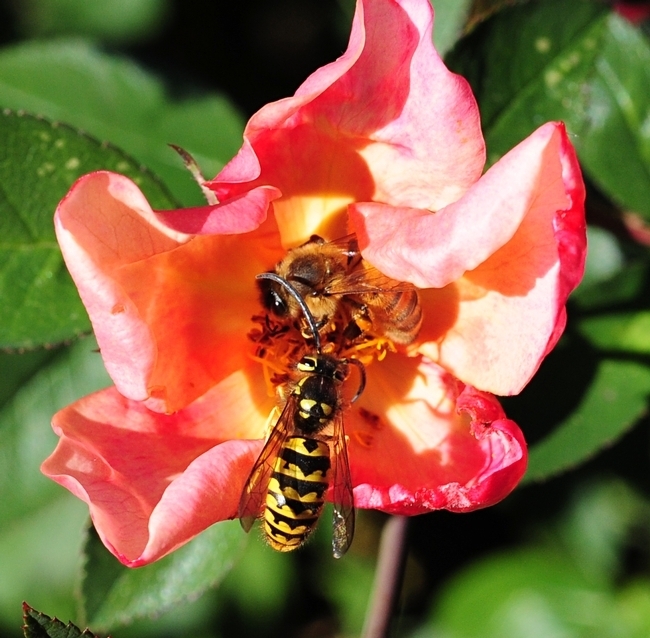
- Author: Kathy Keatley Garvey
Dec. 22 marked the winter solstice, the first day of winter.
But don't tell that to the western yellowjacket, Vespula pensylvanica.
It's supposed to be hibernating, not flying.
But there it is flying around--and sipping nectar--from flowering Algerian ivy climbing a fence in Vacaville, Calif.
It has company. Nearby, several other yellowjackets, honey bees and hover flies are participating in the nectar feast.
Not much is blooming this time of year!
So, what is winter solstice? According to the Farmer's Almanac, "Winter solstice is the day with the fewest hours of sunlight during the whole year. In the Northern Hemisphere, it always occurs around December 21 or 22. (In the Southern Hemisphere, it is around June 20 or 21.)"
Now the days are getting longer.
Is it spring yet?
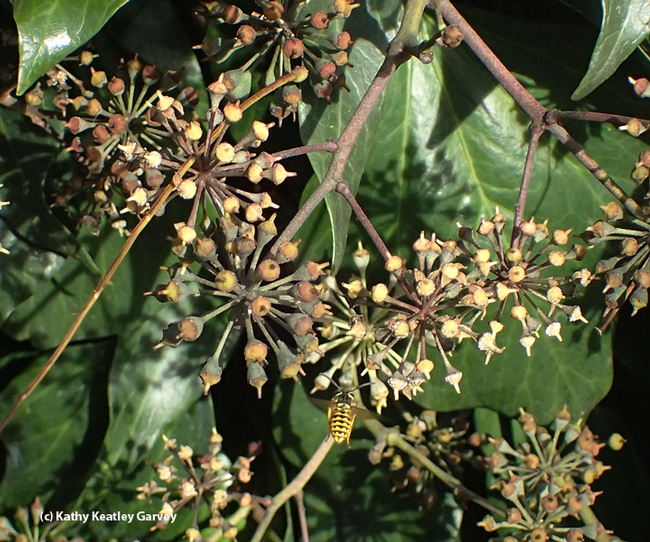
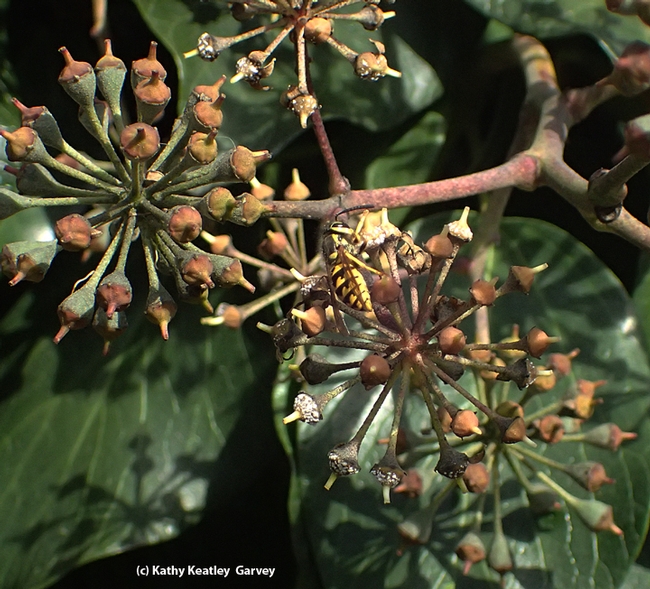
- Author: Kathy Keatley Garvey
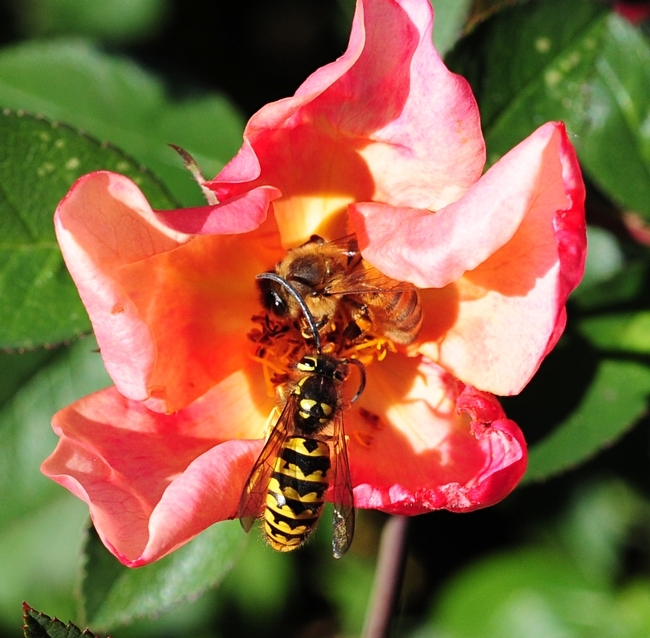
A recent visitor at a camp in the Sierra Nevada mountain range witnessed a large number of wasps and stinging behavior. They crowded around the picnic tables (ah, meat!) and sipped from soda cans (ah, sugar!) She wondered if they were yellowjackets or European paper wasps.
From the description and behavior: yellowjackets.
"European paper wasps (Polistes dominula) are not scavengers," says Lynn Kimsey, director of the Bohart Museum of Entomology and a professor of entomology at UC Davis. "They only take live insects, particularly caterpillars. Western yellowjackets, Vespula pensylvanica, are serious scavengers and are major pests in the Sierra and elsewhere. Their colonies are annual, which means that fertilized new queens must overwinter in protected places until it warms enough in the spring to begin new colonies. As the new colonies are building they need a lot of protein for their babies. The larger the colonies get the more they need."
"If many new queens survived the winter because temperatures were warmer and drier than usual then there will be many colonies to deal with, all competing for food. By late in the season the colonies go more into maintenance mode, needing a lot of sugar. They aren't feeding many babies, which need protein, and the large number of adults need sugar for fuel."
"At this point, control is largely useless," Kimsey says. "Control measures need to be started in the mid to late spring and the best control method is the use of baited traps, not spraying. Also when colonies are found they need to be removed--this needs to be done at night. These wasps nest in cavities, mostly in the ground but also in attics, wall voids and hollow trees if available. The large number of stings suggests that a colony or colonies were nearby."
"So at this point it's best to hope for a long cold, wet winter," Kimsey says.
The UC Statewide Integrated Pest Management Program (UC IPM) provides a wealth of information on Western yellowjackets and paper wasps on its PestNote: "In Western states there are two distinct types of social wasps—yellowjackets and paper wasps. Yellowjackets are by far the most troublesome group, especially ground- and cavity-nesting ones such as the western yellowjacket, which tend to defend their nests vigorously when disturbed. Defensive behavior increases as the season progresses and colony populations become larger while food becomes scarcer. In fall, foraging yellowjackets are primarily scavengers, and they start to show up at picnics and barbecues, around garbage cans, at dishes of dog or cat food placed outside, and where ripe or overripe fruit are accessible. At certain times and places, the number of scavenger wasps can be quite large."
"Paper wasps are much less defensive and rarely sting humans," according the to the UC IPM PestNote. "They tend to shy away from human activity except when their nests are located near doors, windows, or other high-traffic areas."
The UC IPM authors point out that "Typically, previously mated, overwintering yellowjacket and paper wasp queens begin their nests in spring when the weather becomes warm. The queen emerges in late winter to early spring to feed and start a new nest. From spring to midsummer, nests are in the growth phase, and larvae require large amounts of protein. Workers forage mainly for protein at this time—usually other insects—and for some sugars. By late summer, however, the colonies grow more slowly or cease growth and require large amounts of sugar to maintain the queen and workers; foraging wasps are particularly interested in sweet things at this time. Normally, yellowjacket and paper wasp colonies live only one season. In very mild winters or in coastal California south of San Francisco, however, some yellowjacket colonies survive for several years and become quite large."
UC IPM has posted an informative YouTube video, "Distinguishing Between Yellowjackets, Wasps, and Look Alikes." Look closely and you can see that those European paper wasps have distinctive orange antennae. Yellowjacket antennae are black.
Or, to put it another way: Yellowjacket antennae are black, like the Oakland Raiders' logo, and European paper wasp antennae are orange, like the logo of the San Francisco Giants.
